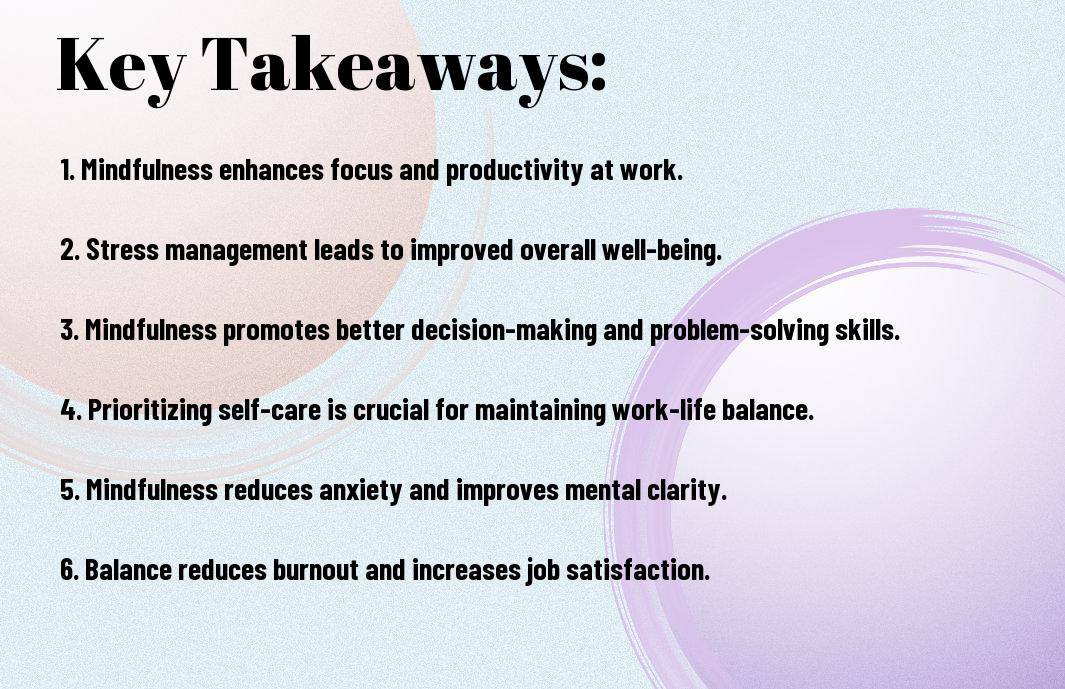
Newsletter Subscribe
Enter your email address below and subscribe to our newsletter

Enter your email address below and subscribe to our newsletter

With the constant demands of modern life, finding a balance between work and personal time can be challenging. Stress has become a common companion for many individuals in their pursuit of success, but it can take a toll on both mental and physical health. In this blog post, we will probe into the reasons why choosing mindfulness over stress can be the key to achieving a harmonious work-life balance.


Little do we realize that the key to achieving work-life balance lies in the practice of mindfulness. According to a Forbes article, the emphasis should not be on striving for an elusive equilibrium between work and personal life but on being fully present in each moment.
Mindfulness can be defined as the practice of paying attention to the present moment without judgment. It involves being fully aware of what is happening around and within us, including our thoughts, feelings, and bodily sensations. The core concepts of mindfulness include acceptance, non-reactivity, and compassion towards oneself and others.
Mindfulness has gained popularity in recent years due to its proven benefits supported by scientific research. Studies have shown that regular mindfulness practice can lead to reduced stress, improved focus, enhanced emotional regulation, and increased overall well-being. The practice of mindfulness has been linked to structural changes in the brain that support better attention and emotional control.
Nowadays, in our fast-paced world, it’s easy to overlook the signs of stress as we navigate through our daily routines. However, being able to recognize the signs of stress is vital in order to address it effectively and prevent its negative impacts on our work-life balance.
Recognizing the physical and mental symptoms of stress is the first step in managing it. Physical symptoms can manifest as headaches, muscle tension, fatigue, and changes in appetite. On the other hand, mental symptoms may include irritability, anxiety, difficulty concentrating, and feelings of being overwhelmed. It’s crucial to pay attention to these signs as they can affect both our work performance and personal life.
Health experts emphasize the long-term impacts of stress on our health and well-being. Chronic stress can lead to serious health issues such as heart disease, obesity, depression, and weakened immune system. These conditions can significantly impact our quality of life, making it vital to address stress before it escalates.
Symptoms of stress should never be ignored, as they can lead to severe health consequences if left unchecked. It’s important to prioritize self-care and seek support when needed to maintain a healthy work-life balance and overall well-being.

Any professional who desires a healthy work-life balance must prioritize setting clear boundaries between their work and personal life. This separation is crucial in order to prevent work-related stress from seeping into personal time and vice versa. By establishing boundaries, individuals can create a sense of structure and routine that allows them to fully focus on work during work hours and dedicate their personal time to relaxation and rejuvenation.
Work environments can often be fast-paced and demanding, leading to increased stress levels among employees. Incorporating mindfulness techniques in the workplace can greatly benefit individuals seeking to achieve a better work-life balance. Mindfulness practices such as deep breathing exercises, mindful walking, and short meditation sessions can help employees cultivate a sense of presence and awareness in the moment, allowing them to navigate work challenges with more clarity and calmness.
Between deadlines and meetings, taking a few minutes to practice mindfulness can make a significant difference in how individuals approach their work tasks. By incorporating mindfulness techniques into their daily routine, employees can enhance their overall well-being and productivity while simultaneously fostering a healthier work-life balance.
Despite the hectic nature of modern life, it is necessary to integrate mindfulness practices into our daily routines to achieve a sense of balance and inner peace. Mindfulness does not have to be a separate activity but can be woven seamlessly into our existing habits and schedules.
The key to integrating mindfulness into your daily routines is to start small and be consistent. Begin by incorporating short mindfulness exercises into activities you already do, such as mindful breathing while waiting in line or mindful walking during your daily commute. By practicing mindfulness in these small moments, you can gradually expand the practice to other parts of your day.
For those looking to cultivate a deeper sense of mindfulness, consistency is paramount. Consistently practicing mindfulness can help rewire the brain and create new neural pathways that support a greater sense of presence and awareness.
For best results, aim to practice mindfulness daily, even if it’s just for a few minutes. Over time, these consistent efforts will lead to a more natural state of mindfulness that extends beyond formal practice sessions.

All too often, we face obstacles in our journey towards cultivating mindfulness in our daily lives. It is crucial to acknowledge these challenges and develop strategies to overcome them. A helpful resource to navigate these hurdles is the article on 7 Tips to Balance Your Work & Life with Mindfulness. These tips can offer practical advice on integrating mindfulness practices into your routine and finding harmony between your professional and personal life.
With the fast-paced nature of modern life, it is common to encounter resistance and distractions when trying to engage in mindfulness practices. It is vital to approach these challenges with a sense of self-compassion and understanding. Instead of viewing distractions as failures, see them as opportunities to gently redirect your focus back to the present moment. By acknowledging and accepting these obstacles without judgment, you can cultivate a more resilient and sustainable mindfulness practice.
Creating a supportive environment for mindfulness can significantly enhance your practice and overall well-being. Surrounding yourself with individuals who value and respect mindfulness can provide a sense of community and encouragement. Moreover, establishing a dedicated space in your home or workplace for mindfulness activities can serve as a visual reminder to engage in regular practice. For instance, setting up a cozy meditation corner with cushions, candles, and soothing music can create a tranquil atmosphere conducive to mindfulness.
Not all impacts of mindfulness on work-life balance can be quantified. The qualitative benefits of mindfulness practices are often experienced on a personal level and can significantly influence an individual’s overall well-being. Many individuals who have adopted mindfulness in their daily routines report feeling more focused, less stressed, and better equipped to handle the challenges that arise in both their professional and personal lives.
On a qualitative level, mindfulness has been shown to enhance self-awareness, emotional intelligence, and the ability to cultivate a sense of inner peace. Personal testimonies highlight how mindfulness practices have helped individuals develop a more positive outlook, improve relationships, and achieve a greater sense of overall satisfaction and fulfillment in their lives.
Measuring the impact of mindfulness on work-life balance also involves examining quantitative evidence and research findings. Studies have shown that individuals who regularly practice mindfulness techniques experience lower levels of stress, increased resilience, and improved cognitive functions. Research findings have indicated that mindfulness can lead to better decision-making, enhanced creativity, and increased productivity in the workplace.
Impact assessments through surveys and data analysis have demonstrated a clear correlation between mindfulness practices and improved work-life balance. Quantitative measures have shown reductions in absenteeism, fewer instances of burnout, and greater job satisfaction among individuals who incorporate mindfulness into their daily routines.
The key to achieving work-life balance lies in the practice of mindfulness over stress. By choosing mindfulness, individuals can cultivate a sense of awareness, presence, and acceptance that allows them to navigate the demands of both work and personal life with greater ease and effectiveness. Mindfulness enables individuals to manage stress more effectively, enhance their well-being, and ultimately lead a more balanced and fulfilling life.
By incorporating mindfulness practices into daily routines, individuals can reduce the negative impact of stress, improve their focus and productivity, and create a more harmonious relationship between work and personal life. Making the conscious choice to prioritize mindfulness over stress is a powerful way to achieve a sustainable work-life balance that fosters overall health and well-being.
A: Mindfulness is the practice of being present and fully engaged in the moment. It helps individuals manage stress, improve focus, and maintain a healthy work-life balance by promoting awareness and acceptance of thoughts and feelings.
A: Mindfulness can help achieve work-life balance by reducing stress, increasing self-awareness, improving emotional regulation, and fostering a sense of overall well-being. It allows individuals to make conscious choices about how they allocate time and energy between work and personal life.
A: Some mindfulness techniques include deep breathing exercises, meditation, body scans, mindful walking, guided imagery, and mindful eating. These practices can help individuals stay grounded and focused amidst the demands of work and personal life.
A: Mindfulness can improve productivity at work by enhancing focus, attention to detail, decision-making skills, creativity, and overall job satisfaction. It allows individuals to work more efficiently and effectively by being fully present in the tasks at hand.
A: High levels of stress can negatively impact work-life balance by leading to burnout, fatigue, decreased productivity, strained relationships, and health issues. Managing stress through mindfulness can help create a more harmonious equilibrium between work and personal life.
A: Yes, mindfulness practices can be integrated into a busy work schedule by taking short breaks for deep breathing, practicing mindfulness during routine tasks, setting boundaries around work hours, and incorporating mindfulness techniques into meetings or work projects.
A: The benefits of mindfulness in achieving work-life balance can be experienced in a relatively short period, often within a few weeks of consistent practice. However, the long-term benefits continue to grow as mindfulness becomes a habit and a way of life.